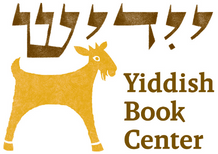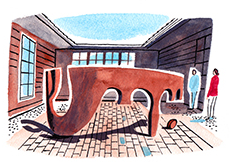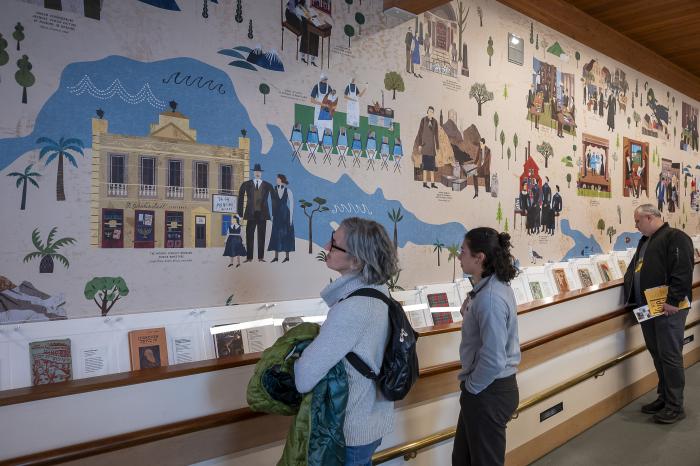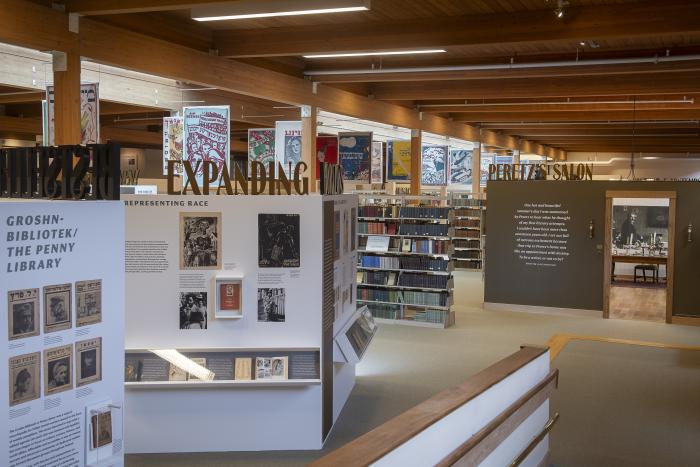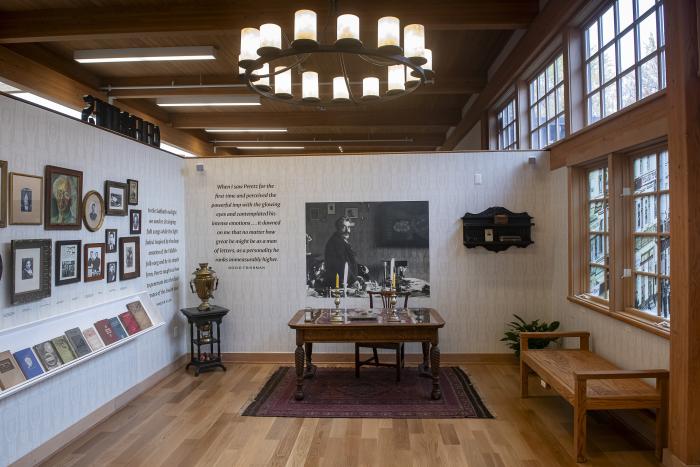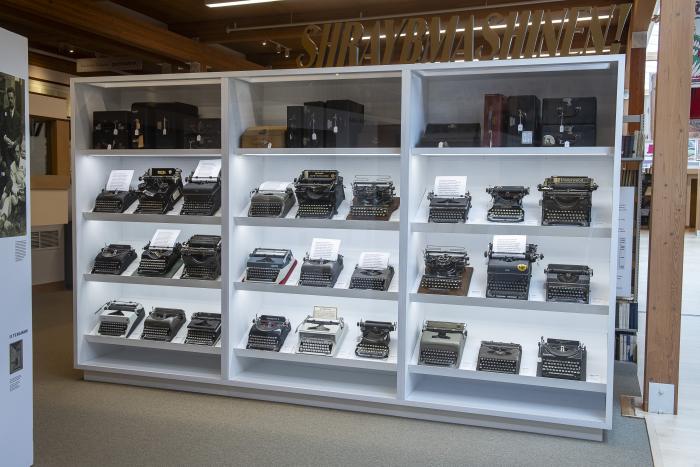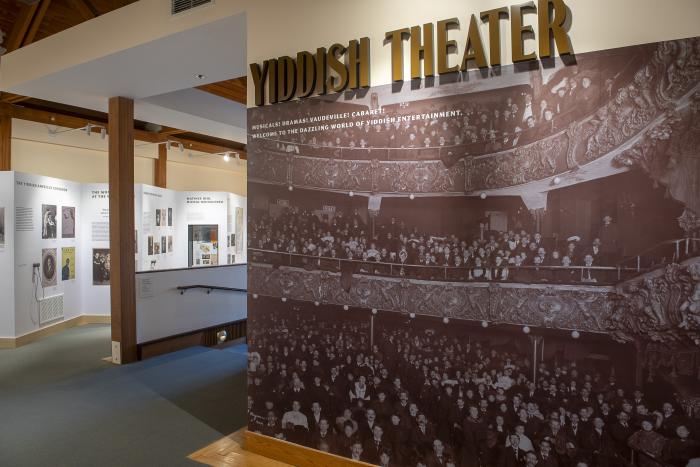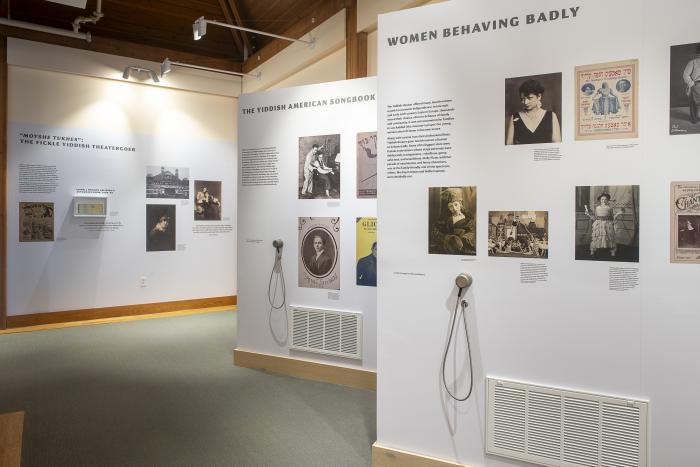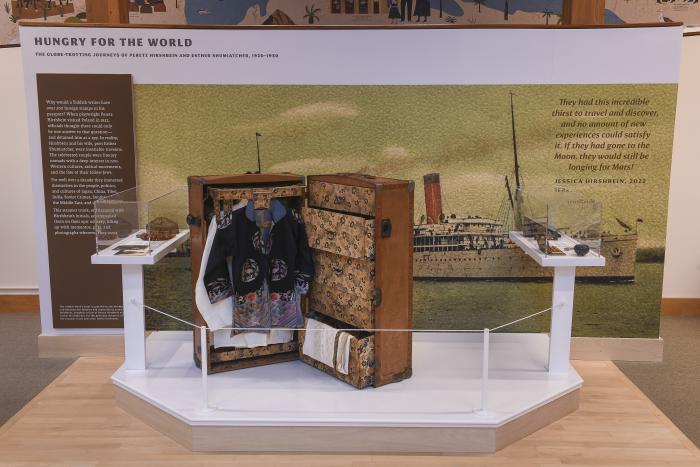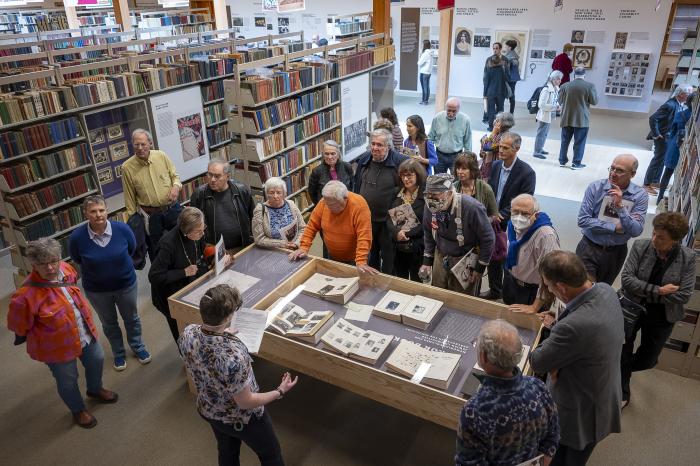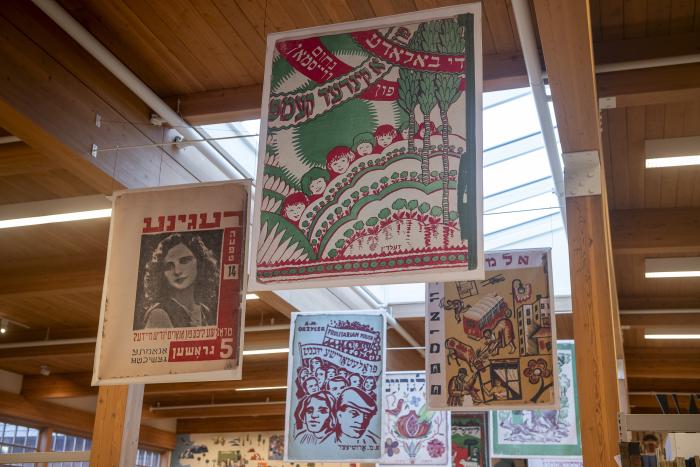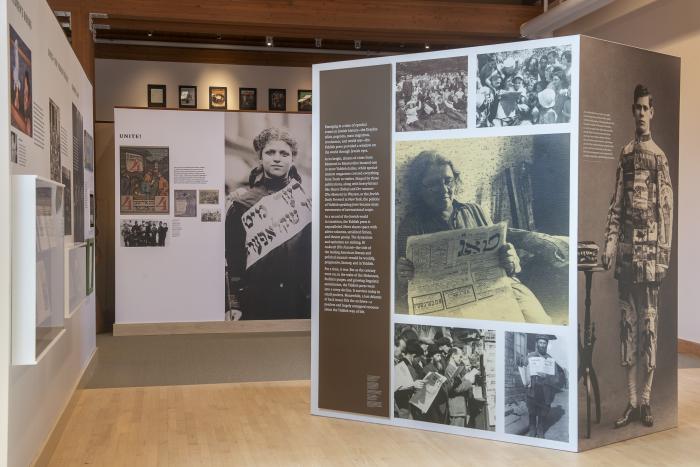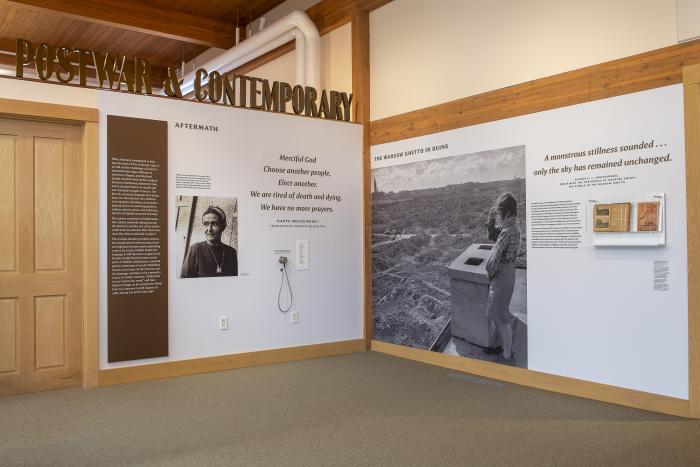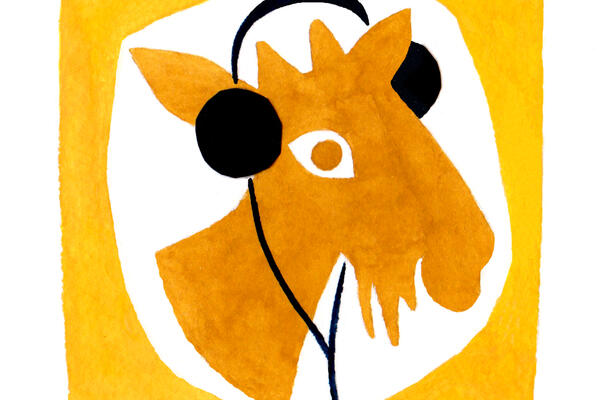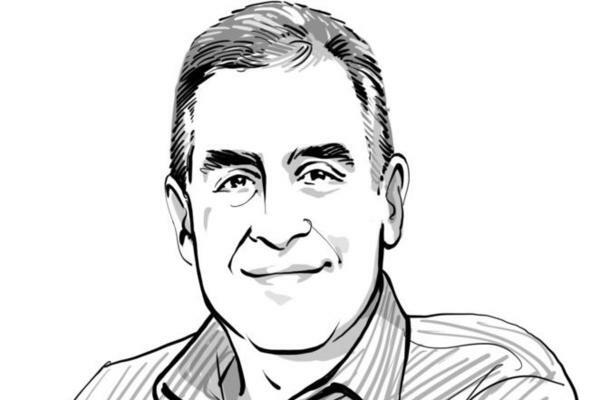On View
The Yiddish Book Center's landmark core exhibition
About Yiddish: A Global Culture
Yiddish: A Global Culture, now on view, is our groundbreaking permanent exhibition. Global in scope, yet deeply personal, it tells the extraordinary story of modern Yiddish culture through hundreds of rare objects, family heirlooms, photographs, music, and videos. It is a rich and revelatory account that places Yiddish at the heart of the modern Jewish story.
The exhibition displays artifacts from the Center’s collections or on special loan, all shown in public for the first time. Highlights include a 60-foot color mural of global “Yiddishland” by illustrator Martin Haake; an enormous hand-drawn 1945 micrographic portrait of Yiddish activist Chaim Zhitlowsky, composed of thousands of miniature letters from his selected texts, created in Buenos Aires by immigrant textile worker Guedale Tenenbaum; a well-worn leather medicine ball, used by the popular Yiddish novelist Sholem Asch when he relocated to the United States in the 1940s; and vintage clothes and a leather steamer trunk from the 1920s that were used by the celebrated Yiddish literary couple Peretz Hirshbein and Esther Shumiatcher on their decade-long travels around the world.
Visitors can also explore a re-creation of the turn-of-the-century Warsaw apartment of writer I. L. Peretz, whose legendary salon stood at the forefront of Yiddish modernism in the 1900s and 1910s. The period reproduction features books, profiles of writers and artists in Peretz’s circle, a soundscape of voices from the salon, a re-creation of Peretz’s desk, and wallpaper based on original photographs.
Yiddish: A Global Culture is the Center’s new permanent exhibition and will be on display for many years to come.
Yiddish: A Global Culture Sections:
The exhibition's seventeen featured sections (listed below) present a richly visual and revelatory account of a vibrant and interconnected Yiddish civilization, from the mid 19th century to the present moment.
- Yiddishland: Transnational Yiddish
- Expanding Horizons: Yiddish as a Gateway to New Worlds, New Lives
- Bestsellers: Dime Novels, Romance Fiction, and Workers’ Libraries
- Modernism: Yiddish Avant-garde, 1914–1939
- Soviet Yiddish: From Revolutionary Promise to Murderous Repression
- Women's Voices: Gender, Stereotypes, and the Struggle for Equality
- Shraybmashinen!: Yiddish Typewriters and Typists
- Khurbn / Holocaust: Martyrs, Survivors, and Books of Remembrance
- Celebrities: Culture Heroes and Commercial Images
- The Hirshbein/Shumiatcher Trunk: The Steamer Trunk That Travelled the World
- Peretz's Salon: Yiddish Pride and Jewish Renewal
- Saving a Culture: Preserving the Past, Enabling the Future
- Music: Songs and Sounds of Synagogue, Street, and Second Avenue
- Press & Politics: Mass Newspapers and Mass Politics
- Postwar & Contemporary: The Response to Catastrophe: Resilience and Renewal
- Theater: The Global World of Yiddish Entertainment
- Story Cases: Sixteen unique objects and the stories behind them
What people are saying about Yiddish: A Global Culture:
“Here in front of me, accessible yet fragile, were treasures of the Yiddish culture I’ve come to care about so deeply. I’ve rarely felt more intimately connected to Yiddishkeit in all its wonder and variety.” Jennifer Stern, the Forward
"Two words about the new exhibit at Amherst's Yiddish Book Center, Yiddish: A Global Culture: AMAZING & GO (experience it). It is an extraordinary and inspiring accomplishment. I cannot wait for my next visit.” —Mindy Domb, Massachusetts State Representative
“I was really impressed by the breadth of topics that were covered. I was so excited to see how much there was about women’s involvement and about how they viewed their own involvement, and it was also really exciting to see all of the contemporary engagement with Yiddish. I loved seeing testimony from a few people I knew...I was looking at [the theater exhibit] and I started crying a little because it was just a very visceral example to me, as I was doing a show of Yiddish continuity, about how people have been radically engaging with Yiddish for hundreds and hundreds of years.” — Eliza Menzel, actor, Indecent (Smith College)
Yiddish: A Global Culture in the press
“Yiddish, Global and Local: Two Exhibitions on a Vibrant Jewish Language,” by Lou Cove via The CANVAS Compendium: Dispatches from the New Jewish Renaissance
“The Daily Heller: Preserving a Moderne Language in Word, Picture and Design,” by Steven Heller via PRINT Magazine
“A Trip to Yiddishland: The Yiddish Book Center’s new exhibit goes beyond the ‘great men’ in our cultural history,” by Rokhl Kafrissen via Tablet Magazine
“An exhibit to kvell over: Expansive new Amherst exhibit looks at the global impact of Yiddish,” by Steve Pfarrer via Daily Hampshire Gazette
“Magnificent permanent exhibit opens at Amherst’s Yiddish Book Center,” by Jennifer A. Stern via The Forward
“At Amherst’s Yiddish Book Center, a new exhibition speaks volumes about Yiddish as ‘a global culture,’” by A.Z. Madonna via The Boston Globe
“See 6 Highlights From a New Show on the Global Footprint of Yiddish Culture—From Avant-Garde Puppets to Cubist Book Covers,” by Richard Whiddington via Artnet
“Yiddish reveals a language of Global Culture,” by Kate Abbott via By the Way Berkshires
“Is the world’s first Yiddish museum in Amherst?” by Aaron Simon Gross via The Berkshire Eagle
“'Yiddish: A Global Culture’ - Telling the Story of a Jewish Counterculture,” by Albert Stern via Jewish Federation of the Berkshires
“25 years after opening, Yiddish Book Center overhauls its core exhibit for a wider audience,” by Andrew Silow-Carroll via Jewish Telegraphic Agency
“Con la Argentina como protagonista. La lengua de las comunidades judías ashkenazíes, objeto de una mega muestra en EEUU,” by Cecilia Scalisi via La Nacion
“Yiddish Book Center Celebrates 150 Years of Modern Jewish Creativity,” via Fine Books & Collections Magazine
Exhibition Support
Yiddish: A Global Culture has been made possible in part by a grant from the National Endowment for the Humanities: Democracy Demands Wisdom.
Additional major funding support has come from The Kaplen Brothers Fund, the Estate of Dr. Thomas Zand, The Simha and Sara Lainer Family Foundation, Dr. Martin Peretz, Arthur Sands, Leona Kern, The David Berg Foundation, Dr. Jesse M. Abraham and Amy Peck Abraham, The Morris and Beverly Baker Foundation, The Malka Fund at Jewish Communal Fund, Ben Shneiderman, and the Dr. Matthew A. Budd and Rosalind E. Gorin Fund at Combined Jewish Philanthropies.
